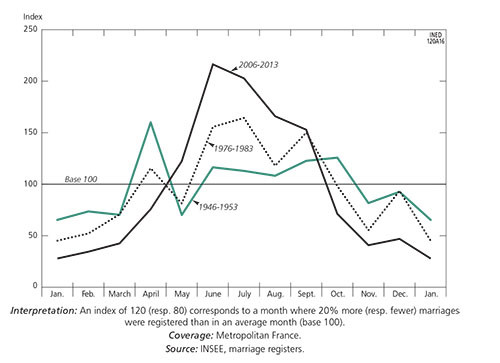La sexualité qui vient [publication]
Publication on the results of INED statistical study :ENVIE (2022-2023) on sexuality and intimate relationships among young adults.
Publication on the results of INED statistical study :ENVIE (2022-2023) on sexuality and intimate relationships among young adults.

Depuis quelques décennies, la plupart des pays européens connaissent des niveaux de divorces et séparations élevés. Existe-t-il un lien entre chômage et instabilité des couples ? Ce travail de recherche montre que le chômage des hommes augmente systématiquement le risque de séparation alors que celui des femmes a moins d’incidence sur la stabilité du couple.

Do stepfathers and stepmothers play the same roles in the lives of their partner’s children? Does the amount of time stepchildren spend in the household affect the degree of involvement of their stepfather or stepmother?

Using data from the joint INED-INSEE “Parcours individuels et conjugaux” survey, researchers Wilfried Rault and Arnaud Régnier-Loilier compared the time it takes individuals in France to indicate their wedding date or the date they formalized their civil union by respondent’s sex; they also studied the individual and social meanings people associate with these events.

Si l’écart entre hommes et femmes diminue, cela résulte principalement d’une réduction du temps consacré par les femmes aux tâches ménagères.

With other variables controlled for, attending a crèche positively affects language acquisition, while having little effect on motor skill development or behavior.

The "Longitudinal study on access to autonomy after a placement" makes it possible for the first time in France to measure the living conditions of young people in care at the end of their care.

En l’espace de quelques années, le nombre de Pacs a augmenté au point de se rapprocher du nombre annuel de mariages. Wilfried Rault, chercheur à l’Ined, nous éclaire sur les grandes évolutions du Pacs depuis 20 ans.

Access to abortion around the world is highly unequal. In African and Latin American countries access may be restricted to particular causes of pregnancy or totally outlawed.

The ELFE study centres on childhood at this stage, then it is natural to have them communicate directly through computer games, an appropriate medium for their age and generation.

We commonly encounter two opposed discourses on love, Michel Bozon takes quite a different perspective.

Boys reach puberty at around 15 years—later than girls, who usually begin menstruating around age 13.

Since the law no. 2002-304 of 4 March 2002 applicable to children born since January 2005, parents can now choose between four options for their child’s family name

La massification scolaire a entraîné un développement des mises en couple durant les études, en particulier pour les premières relations. Les couples formés dans ce contexte se révèlent généralement plus homogames, c’est-à-dire proches en termes de diplôme et de profession, que les autres.

What toys do boys and girls prefer at age two? Do children’s play activities reflect family or social influences? INED explore the role of siblings, parents, and social background in children’s gendered play.

With the rise in number of dual-earner couples and higher female educational levels, couples in which women earn more than their partners are increasingly frequent.

Mothers who share physical child custody with the child(ren)’s father after divorce or legal dissolution of their civil union are more likely to be working than mothers with residential custody

Angèle Jannot, a PHD student at INED, questions the influence of income and degree levels on wealth inequalities within parental couples.

La situation des femmes sur le marché du travail a connu une évolution radicale ces 50 dernières années

differences between male and female married couples

Objets de débat, les sites et les applications de rencontres sont accusés de rien de moins que d’avoir tué l’amour. Ces critiques illustrent la consternation et la réprobation suscitées par ce nouveau mode de rencontres. Sont-elles seulement fondées ?


For the 70th anniversary of its founding, the journal Population has been republishing articles from its 1946 issues, each commented upon by present-day researchers.

By 2050 in China and India, the number of single men seeking to marry is expected to exceed the number of eligible women by over 50%. This suggests the degree of marriage market saturation.
At age 17, about half of French teenagers have experienced their first sexual intercourse. With a median age of 17.2 for women and of 16.4 for men in 2010, the gap between the sexes has narrowed to just a few months.

This month’s edition of Population & Societies features an original study of 10-year-olds’ participation in domestic chores. Based on data from the Elfe cohort of children, it finds that nine out of ten children lend a hand with tasks such as setting and clearing the table or looking after family pets, but also reveals significant disparities between boys and girls by family type and social background.

Research has been increasingly attentive in recent years to sexual violence in the lives of gay and bisexual men. However, those studies have focused mainly on sexual abuse in childhood, overlooking violence in adulthood in these male sexual minority groups, as well as their diverse ways of life, the varied types of violence undergone, and the situations and contexts in which it is experienced.

What does the term “complex households” cover? What proportion of households in French Polynesia are “complex”?

Since 2000, 31 countries on every continent have passed legislation granting same-sex couples the right to marry. Australia was the 27th in 2017.

Generally speaking, couples tend to synchronize their sleep: the members of 4 out of 5 couples go to bed and get up at the same times. The sleep of retired couples, non-working couples under age 60, and relatively well-off working couples is fairly synchronized whereas relatively disadvantaged working couples’ sleep is desynchronized.

The student population is a privileged target in terms of prevention but also in terms of information on consent.

How do men and women divide domestic work since the introduction of the 35-hour reform?

Researchers have used ELFE study data (French longitudinal study of children) to examine the possible effects of paternity leave on partners’ sharing of parenting and domestic tasks.

This study, published in Population (2017-3) and based on the 2011 Families and Housing Survey.

Marriage has changed since the 1980s, as attested by the rise in cohabitation outside marriage: in 2011, nearly one in four couples in France were not married.

Heirs and heiresses often marry each other in France, finds a study published in the journal “Population.” Balzac’s Rastignac would have little chance of marrying a rich heiress today.

China, the world’s largest country in terms of population, is now a predominant player on the international economic and geopolitical stage.